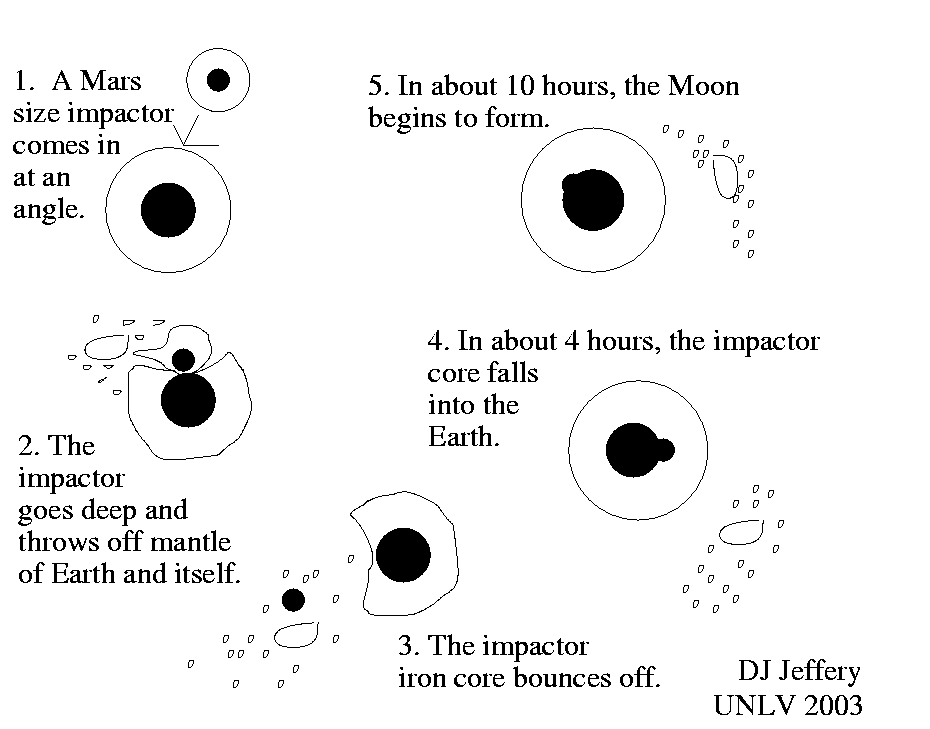
Caption: A cartoon of a common version of the giant impact hypothesis for the origin of the Moon (Se-457).
Features:
- Some million years to about hundred million ears after
the formation of the Earth
and its chemically differentiation,
a protoplanet
impactor of order
the size AND mass
of Mars ♂ impacted the
Earth ⊕
at an angle probably NOT
0°, 90°, or 180° to the
Earth's
direction of
motion
in space
and probably NOT
at zero
impact parameter.
- The oldest moon rocks
brought back by the Apollo program
are ∼ 4.5 Gyr old
(see Wikipedia: Moon rock).
This suggests the impact was ∼ 4.5 Gyr or earlier.
So no later than of order 100 Myr after the
formation of the Earth
which is now given as occurring 4.54(5) Gyr ago
(see Wikipedia: Age of the Earth).
- The hypothetical impactor protoplanet
is often called Theia
after the
mythological Theia
(whose name just means goddess).
The mythological Theia was
Titaness
mother of
Selene,
the Greek mythological
Moon goddess.
- The impactor
was also chemically differentiated
with an iron core and
a silicate
mantle.
- There was deep impact of the impactor on
the Earth
and the cores
of the
Earth and impactor bounced initially
and then merged.
Essentially much of the impactor combined with Earth and significantly increased its size. It is possible that very dense materials like gold and platinum were spread in the Earth's crust by the impactor (SRJ-168). It has been wondered how these materials are abundant as they are in the Earth's crust.
- Some mantle debris from
both objects was thrown into space: it
became ejecta.
- Some of the ejecta fell back to Earth and some escaped
Earth altogether.
But some of the ejecta went into orbit and began to accrete under self-gravity to form the primordial Moon within a short period that is probably in the range from tens of days to 100 years (see Wikipedia: Giant impact hypothesis: Basic model of impact).
- The heat energy of the ejecta caused
it to outgas
almost all of its volatiles leaving it volatile-depleted.
This explains why Moon rocks are
are volatile-depleted (HI-150).
- The ejecta that formed the Moon
was initially molten or very hot and also contained
radioactive isotopes.
Collectively, the heat energy
was sufficient to cause the early
Moon to be molten and
undergo chemically differentiation.
- A hot iron core,
mantle,
and crust formed
(see Wikipedia: Internal structure of the Moon).
- The original lunar crust
was heavily impacted by
heavy bombardment
during the 1st gigayear of the
Solar System.
It became the strongly cratered, light-colored
lunar highlands
- Some lunar impactors were very large and weakened the crust sooner or later allowing
lava from the hot interior to flow out
into the giant
impact craters
(i.e., giant lunar basins).
The lava solidified into
relatively dark-colored, giant lava plains
which we call lunar maria.
Most lunar maria probably formed more than 3 Gyr ago though some regions may be as young as 1.2 Gyr (see Wikipedia: Lunar maria: Ages).
- The giant impact hypothesis has great advantages
as a theory:
- It explains why Moon lacks
volatiles and
is low in iron compared to the
Earth, but has a surface composition much like that
of the Earth's
mantle.
- Evidence from impact crater shows that
large impacts were common in the early Solar System.
In early Solar System
overall theory of the early Solar System
protoplanet with many leftover
protoplanets still swarming around.
So a giant protoplanet impactor is NOT
improbable.
- Computer simulations show that
giant impact hypothesis
is physically quite possible.
But, of course, they don't tell us exactly what the impactor was or
how it hit. All we can do is create plausible scenarios and calculations
that lead to what we find today:
Earth
and Moon.
- See Moon formation and evolution videos below (local link / general link: moon_formation_evolution_videos.html).
- It explains why Moon lacks
volatiles and
is low in iron compared to the
Earth, but has a surface composition much like that
of the Earth's
mantle.
Image link: Itself.
Local file: local link: moon_formation.html.
File: Moon formation file: moon_formation.html.